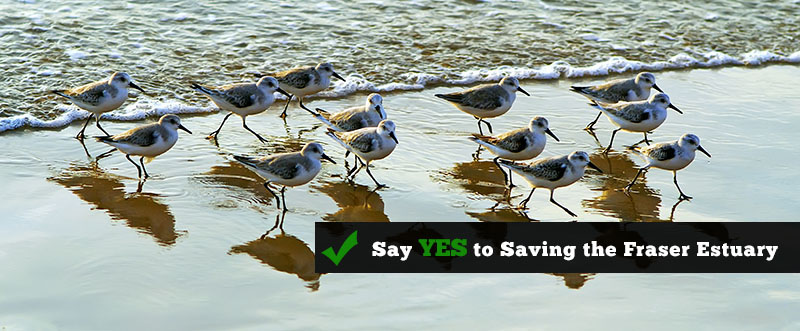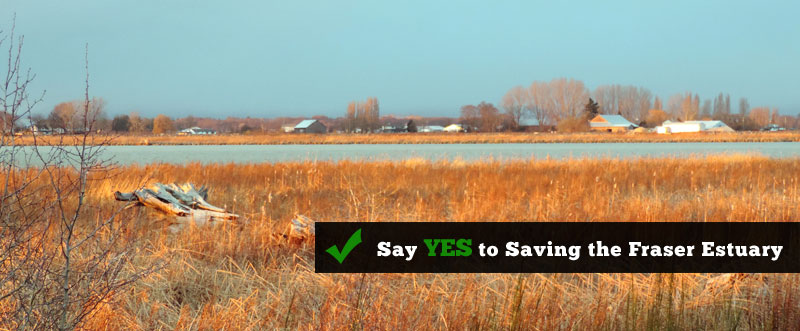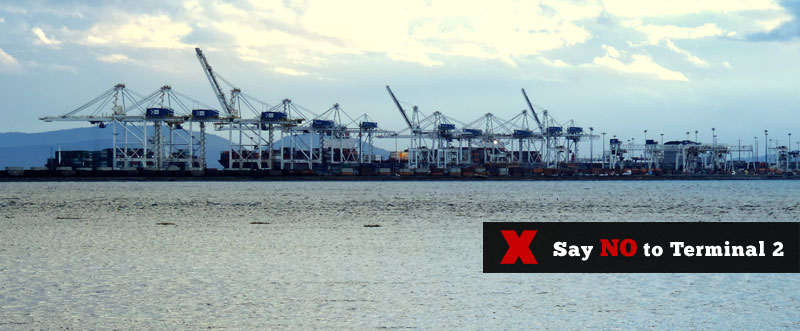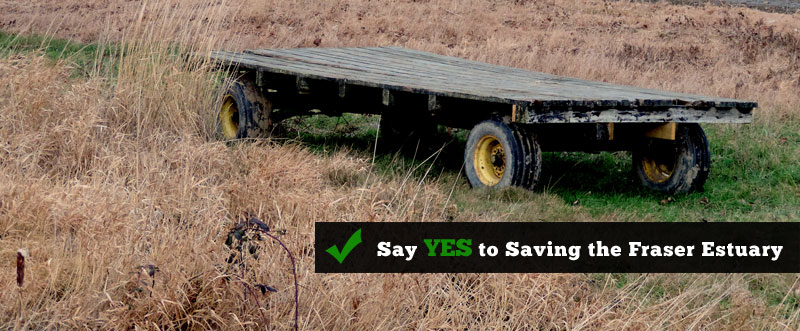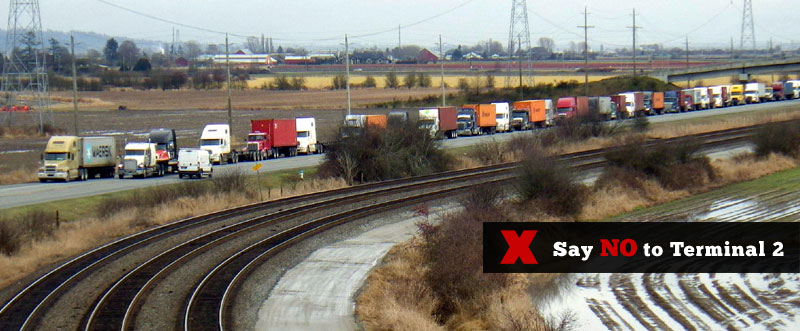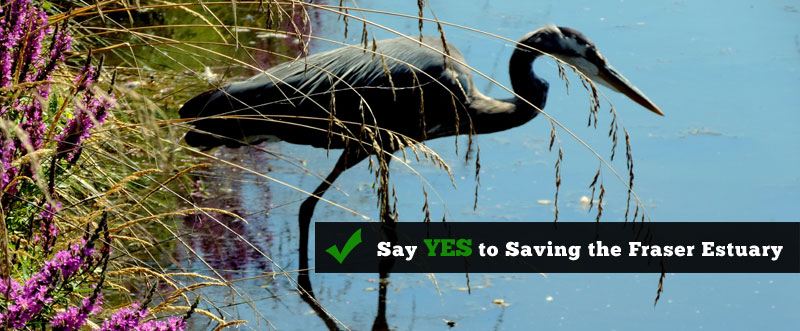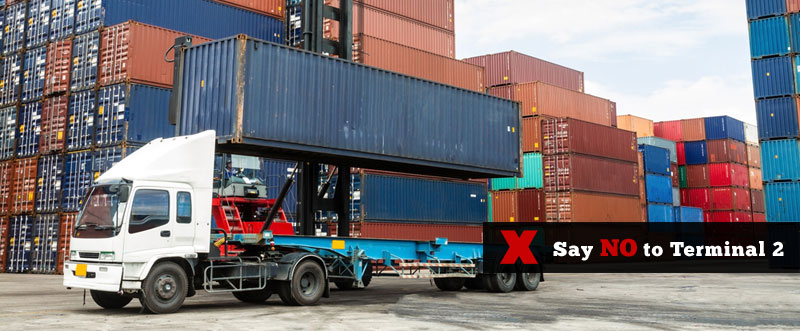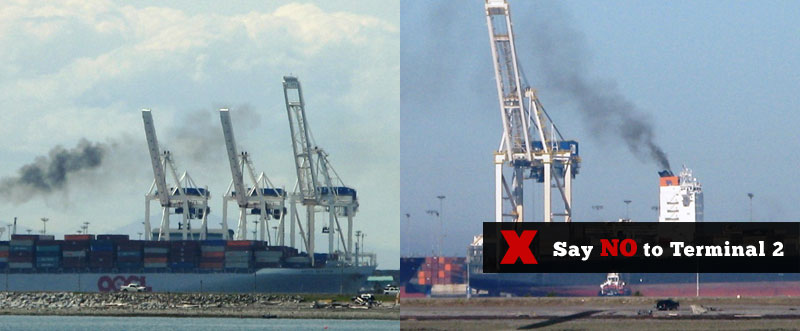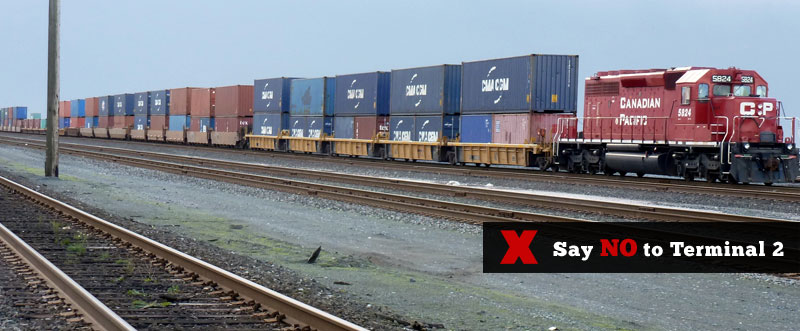Against Port Expansion in the Fraser Estuary BC
APE (Against Port Expansion in the Fraser Estuary BC) is a group of concerned citizens who recognize that plans for container terminal expansion on Roberts Bank (RBT2) will see the loss of globally-significant wetlands and habitat (classified as a Globally Significant Important Bird and Biodiversity Area - IBA/KBA and under threat) for migratory birds, shorebirds, waterfowl, salmon, herring, crabs and orca whales; degradation of the quality of life for thousands of Lower Mainland residents; and the industrialization of prime agricultural land.
View the latest powerpoint presentation
Roberts_Bank_Terminal_2__March_2024.pptx
Building Roberts Bank Terminal 2 in the Fraser Estuary means:
-
Upsetting Roberts Bank’s natural chemistry
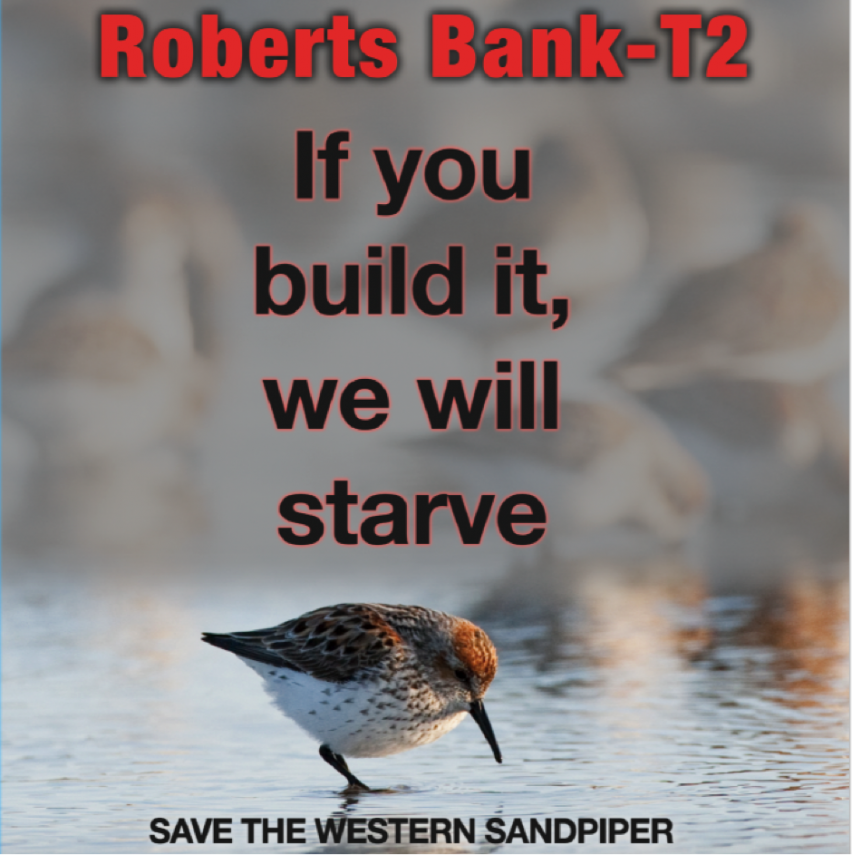
- Destroying the unique quality of its intertidal biofilm
- Breaking the chain of the Pacific Flyway
- Destroying a key refueling stop for migratory birds
- Further declines in the western sandpiper population towards eventual species extinction
- Pushing Orca whales towards their eventual extinction
- Putting juvenile salmon at increased risk
- Further declines in commercial crabbing
- Infringing on First Nations livelihoods and cultural practices
- Increased air, noise and light pollution
- More traffic congestion caused by Port truck traffic
For What? A new $4-6 billion container terminal that can never be economically justified, because there are better cheaper alternatives to satisfy Canada’s trading needs. Demand governments stop this. Email ec.ministre-minister.ec@canada.ca and copy saynotot2@gmail.com
On April 20 2023 the federal cabinet approved RBT2, effectively signing the death certificate for the Fraser Estuary. The BC Government gave its approval on September 28 2023.
Dear Against Port Expansion Community Group Supporters and Members of the Public:
October 13, 2023
Governments Have Betrayed The Environmental Values of the Fraser Estuary
As Executive Director of Against Port Expansion Community Group I write to you, APE Supporters and Members of the Public, after reflecting on the BC Government's approval of Roberts Bank Terminal 2 (RBT2), which effectively ends attempts to stop RBT2 within the federal and provincial legislative framework established to carry out environmental assessments and make decisions. This environmentally disastrous, unnecessary and uneconomic project can still be stopped. Read the letter to find out what you can do to stop the Fraser Estuary from breaching its environmental tipping point.
Read the full letter here:
Governments_Have_Betrayed_The_Environmental_Values_of_the_Fraser_Estuary_APE_Website.pdf
Below is a summary and dateline of the RBT2 project. It was approved:
- Over a mountain of opposition;
- With political interference
- Ignoring Environment Canada scientists’ concerns
- Ignoring significant wide ranging credible research and science, much of it published in peer-reviewed science journals, demonstrating the project’s significant adverse environmental effects that cannot be mitigated.
- Ignoring the facts and evidence.
Major environmental groups, scientists expert in their field, citizen scientists, the Cities of Delta, Richmond and White Rock, MPs, members of the public rose up and voiced their opposition to RBT2. As the final phase of the environmental assessment concluded that opposition grew and grew. The politicians ignored all of that and by approving the project signed the death certificate for what little remains of the natural habitat in the Fraser Estuary and the wildlife that relies on it.
WHEN IT WAS APPROVED THESE WERE THE CABINET MINISTERS KNOWN TO HAVE SUPPORTED RBT2: MESSRS WILKINSON, ALGHABRA, SAJJAN AND CHAMPAGNE
THESE CABINET MINISTERS WERE KNOWN TO OPPOSE RBT2: GUILBEAULT, QUALTROUGH, MURRAY
BUT THEN TRUDEAU SHUFFLED HIS CABINET.
THESE ARE THE MINISTERS STILL IN CABINET. EMAIL EACH OF THEM, ASK THEM TO EXPLAIN WHY THEY IGNORED SCIENCE FACTS AND EVIDENCE AND DEMAND THEY REVIST THEIR APPROVAL
JONATHAN WILKINSON:
minister.ministre@nrcan-rncan.gc.ca
STEVEN GUILBEAULT
ec.ministre-minister.ec@canada.ca;Steven.Guilbeault@parl.gc.ca
CARLA QUALTROUGH:
info@pch.gc.ca; Carla.Qualtrough@parl.gc.ca
FRANCOIS- PHILIPPE CHAMPAGNE: francois-philippe.champagne@parl.gc.ca
TELL THEM TO HONOUR THE AGREEMENTS CANADA HAS SIGNED TO PROTECT THE ENVIRONMENT (MOST RECENTLY AT THE UN BIODIVERSITY CONFERENCE). TELL THEM TO REVERSE THE RBT2 APPROVAL.
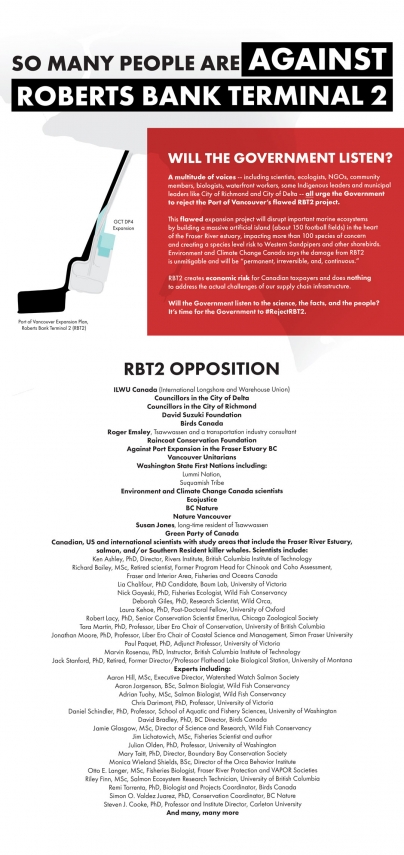
THIS IS THE TORTUOUS PATH THAT LED TO RBT2 APPROVAL
MARCH 2023 STILL NO DECISION - AFTER EIGHT YEARS !!
- MAR. 27 2020 THE FEDERALLY-APPOINTED REVIEW PANEL PUBLISHED ITS REPORT IDENTIFIYING SIGNIFICANT ADVERSE ENVIRONMENTAL EFFECTS IN MANY AREAS SHOULD RBT2 BE BUILT.
- AUG. 24 2020 THE FEDERAL ENVIRONMENT MINISTER PAUSED THE DECiSiON PROCESS AND ASKED THE PORT FOR MORE INFORMATION.
- AUG. 28 2020 THE PORT SAYS IT WILL HAVE COMPLETED GATHERING THE ADDITIONAL INFORMATION PRIOR TO YEAR END
- NOV. 5 2020 THE PORT SAYS IT WILL NOT PROVIDE THE INFORMATION UNTIL SUMMER 2021.
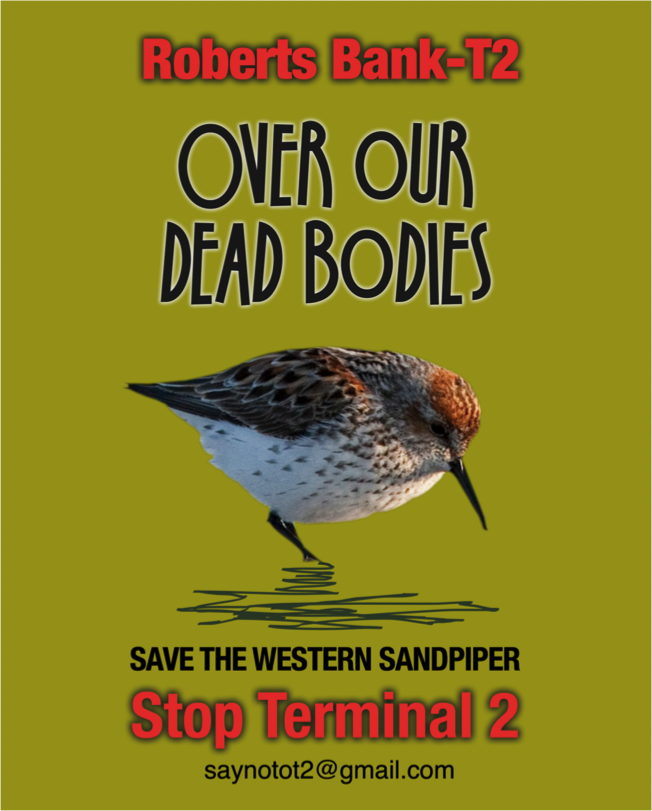
- SEP 24 2021 PORT PROVIDED ITS RESPONSE
- DEC 15 GOVERNMENT PROVIDED A DRAFT OF POTENTIAL CONDITIONS FOR APPROVAL AND OPENED FINAL ROUND OF PUBLIC COMMENT
- MAR 15 2022 PUBLIC COMMENT PERIOD CLOSED WITH THOUSANDS OF OPPOSING SUBMISSIONS
- APR 22 2022 PORT RESPONDED TO SOME OF THE OPPOSING SUBMISSIONS, BUT NOT ON THE KEY ISSUE, BIOFILM
- JUNE 10 2022 PORT RESPONDED ON THE BIOFILM ISSUE. SAME OLD FLAWED SCIENCE, PROMOTING BIOFILM REPLACEMENT WHEN INTERNATIONALLY RECOGNIZED SCIENCE SAYS THIS IS IMPOSSIBLE ON THE SCALE NECESSARY TO REPLACE WHAT WILL BE LOST
- SEPTEMBER 2022 - A WALL OF SILENCE REMAINS OVER OTTAWA ON RBT2
- OCTOBER 26 2022 - ENVIRONMENT CANADA RESPONDS TO THE VFPA WITH A DETAILED ANALYSIS DEMONSTRATING YET AGAIN THAT RBT2 WILL RESULT IN SIGNIFICANT ADVERSE ENVIRONMENTAL EFFECTS THAT CANNOT BE MITIGATED. ECCC SCIENTISTS STATE:
"Given the importance of the Roberts Bank site for the Western Sandpiper, the nutritional requirements for fatty acids of migrating shorebirds, and the predicted effects of the Project on biofilm quantity and quality, ECCC continues to advise that the changes predicted as a result of the Project, as currently designed, would likely constitute an unmitigable species-level risk to Western Sandpipers, and shorebirds more generally". - January 23 2023 Ottawa decides it has all the information it needs to make a decision
- Febuary 2023 - The RBT2 Decision is with the Federal Cabinet acting as Governor in Council
- April 3 2023 Still waiting for a decision from Ottawa. Three cabinent ministers are known to support it. Amazing!!!
- April 20 2023. The federal government approves terminal 2 stating
" I (Environment Minister) have determined that the Designated Project (RBT2) is likely to cause significant adverse environmental effectsreferred to in subsection 5(1) of the Canadian Environmental Assessment Act, 2012.In accordance with paragraph 52(4)(a) of the Canadian Environmental Assessment Act, 2012, the Governor in Council (Federal Cabinet) decided that the significant adverse environmental effects referred to in subsection 5(1) that the Designated Project is likely to cause are justified in the circumstances.
THE FIGHT IS NOT OVER
THE FEDERAL GOVERNMENT IGNORED ITS OWN SCIENTISTS AND THEIR CONCERNS.
WE NEED YOUR HELP. EMAIL THE PRIME MINISTER AND DEMAND HE REVERSE THIS DECISION. pm@pm.gc.ca
The govenrment has the science, facts and evidence. Its own scientists say RBT2 will result in significant adverse environmental effects that cannot be mitigated. How much more does the government need to reject this project?
KEEP THE PRESSURE ON THE FEDERAL GOVERNMENT
TELL THEM YOU WILL NOT ACCEPT RBT2 BEING APPROVED.
WRITE TO MINISTER GUILBEAULT. SELECT COPY & PRINT THIS
Attention Minister Steven Guilbeault:

Roberts Bank Terminal 2 (RBT2) is environmentally unsustainable.
Environment and Climate Change Canada scientists have consistently characterized the negative environmental impacts of the RBT2 project as permanent, irreversible and continuous, disrupting and eliminating quality fatty acid production from diatoms in biofilm across Roberts Bank by dampening and reducing salinity. These particular fatty acids are absolutely required by Western Sandpipers and disrupting their production may also have negative implications for salmon and crab production, as well as eulachon a major part of Indigenous heritage. Many international scientists agree, as do Birds Canada, Western Hemisphere Shorebird Reserve Network, BC Nature, Nature Canada and others.
I am opposed to RBT2 and petition you and Cabinet to reverse your approval for this project.
Date___________________________
Signed________________________Email______________________________
Name_______________________________Postal Code__________________
AND MAIL TO
Minister Steven Guilbeault POST FREE
House of Commons
Ottawa, Ontario, K1A0A6
See what others are doing to stop RBT2:
1. Fraser Delta in the International spotlight. Birdlife Interantional has joined the fight to stop RBT2.
https://www.birdlife.org/worldwide/news/waterfowl-winter-refuge-fraser-river-delta-risks-being-lost-forever?utm_source=BirdLife+International+News+Notifications&utm_campaign=a1bb67f58b-Summary_news_notification&utm_medium=email&utm_term=0_4122f13b8a-a1bb67f58b-131704081&mc_cid=a1bb67f58b&mc_eid=0757e28fcf
2. In May 2022 The Garden City Conservation Society published a comprehenisive analysis of all that is wrong with the RBT2 project, under the title Stop RBT2 - To Enable Success, and sent it to the federal Environment Minister and the Cabinet
stoprbt2_enablesuccess_gccs_0.pdf
3. A video by Ranincoast Conservation
https://youtu.be/HkKLY3P2_ys
4. Natural Legacies versus Waste
5. Fraser Voices
6. Georgia Strait Alliance
https://georgiastrait.org/work/species-at-risk/proposed-terminal-2-deltaport-expansion-2/
Canadian Governments and Laws Fail to Protect the Fraser River Estuary
The Boundary Bay Conservation Committee recently prepared and published a paper on Roberts Bank Terminal 2. Read it here:
Canada_failing_to_protect_Fraser_River_Estuary.pdf
As the paper suggests The Canadian Government is ignoring scientific evidence from government and independent experts. The Governments of Canada and British Columbia approved RBT2 based, not on science, but on “justification” for the public good. There is neither economic nor environmental justification.
As a result No one is protecting this globally-important, unique estuary.
Environmental groups challenged the approval in court. In January, 2025, the Federal Court ruled in support of the approval stating government agencies will ensure protection through the process of conditions and permits. These agencies do not have the funding, time, legal authority, or expertise to ensure the protection of the interactive, interdependent processes that create unique, healthy estuarine ecosystems. Such expertise doesn’t exist. Follow-up investigations of projects show that government agencies provide patchwork, rubber-stamp approvals with negligible enforcement.
Furthermore there is no business case for building an island for containers in the Fraser estuary.
With the current and projected volume increases for West Coast container traffic current container terminal capacities in Vancouver and Prince Rupert are sufficient for Canada's trade requirements for many years to come. And when more capacity is required Prince Rupert has the space and capacity to add as many as 5 million TEUs, at half the cost without the environmental degradation that RBT2 will deliver.
The stated cost of RBT2 at $3.5 billion was unrealistic five years ago; an updated and more realistic cost is likely in excess of $6 billion, making it simply not economically feasible. How ironic that public assets and tax dollars will be required to support this uneconomic Project that is not needed and that will cause irreparable damage in the globally-significant Fraser River Estuary.
The Vancouver Fraser Port Authority still needs a Fisheries Act Authorization to proceed. They must not get it. Wildlife species including Western Sandpipers, Salmon stocks and Southern Resident Killer Whales will not survive and will go extinct if RBT2 is built.
Tell the Department of Fisheries not to approve Roberts Bank Terminal 2, because doing so violates the Species At Risk Legislation and will result in wildlife population declines to the point of potential species extinction.
Write to DFO.Minister-Ministre.MPO@dfo-mpo.gc.ca

RBT2 Federal Government Hypocrisy
RBT2 Federal Government Hypocrisy
Canada is losing its way on its environmental agenda. “Justified in the circumstances” is how the federal government approved Roberts Bank Terminal 2.
Is it Justifiable to put wildlife species already in decline on the path to extinction?
Is it justifiable to approve a container terminal that can be built for half the cost elsewhere with little environmental degradation?
Is it justifiable to approve a container terminal that the federal government’s own scientists told them would result in
negative environmental effects that would be immediate, permanent, irreversible, continuous and cannot be mitigated?
These are the questions that the federal government has never answered. That is irresponsible government.
Isabelle Groc a writer, conservation photographer, documentary filmmaker, book author, and speaker based in Vancouver, Canada,
is making a documentary about Roberts Bank Terminal 2. Below is a recent Facebook post of hers that talks to the environmental disaster
that is Roberts Bank Terminal 2.
As the post indicates Isabel is making a documentary and I encourage everyone to find out more by visiting the website.
Get involved.
As Margaret Mead said many years ago:
"Never doubt that a small group of thoughtful committed individuals can change the world. In fact, it's the only thing that ever has."
This is Isabel's post:
"Last week, I have learned that the federal Court has ruled against environmental groups that filed a legal challenge
against the Roberts Bank Terminal 2 Project in the Metro Vancouver region of British Columbia.
The Port of Vancouver’s plan to build a second container ship terminal will destroy 177 hectares of the last intact estuarine habitat in western Canada.
Over 100 species at risk depend on this habitat for survival, including the endangered southern resident killer whales and their food source,
Chinook salmon. Environmental groups argued the federal government breached the Canadian Species At Risk Act
by allowing the destruction of this habitat, a challenge they have now just lost.
We must not give up.
One of the species that will be critically impacted by this project are western sandpipers. They may not be as charismatic as
southern resident killer whales and are often unjustly overlooked in this battle against the megaport.
Yet we must not underestimate the power of these tiny shorebirds that weigh no more than 35 grams and their potential to stop
the Roberts Bank Terminal 2 Port Expansion Project.
We are making a documentary to raise awareness about the importance of Roberts Banks and intertidal mudflats
for the survival of western sandpipers. The birds and what they eat in the mudflats provide a critical opportunity to stop this project:
we can protect the western sandpipers, but also all the species at risk that depend on this habitat, including southern resident killer whales
and pacific salmon.
To learn more about what you can do now and how you can help, read my latest blog on my website:
https://www.isabellegroc.com/saving-western-sandpipers.../
And visit the film website:
Thank you for your support!

How Can Scientists and Major Environmental Groups All be Wrong About Roberts Bank Terminal 2?
Can hundreds of scientists, including federal government scientists, all the major environmental groups in Canada, fisheries experts, birders, wildlife experts, marine mammal researchers and watchers all be wrong? Can the major Canadian port operator be wrong?
Can all these people and groups be wrong? Can PM Trudeau’s cabinet (acting as Governor In Council) be right when it approved the Roberts Bank Terminal 2 (RBT2) project stating it is “justified in the circumstances”?
There is still time to right this wrong. RBT2 still needs a fisheries act authorization.
Write to Fisheries Minister Lebouthilier DFO.Minister-Ministre.MPO@dfo-mpo.gc.ca and tell her not to give RBT2 the fisheries act authorization it needs.
Science, facts and evidence demonstrate RBT2 will denigrate sensitive intertidal habitat critical for the survival of migratory and other shorebirds, with the negative effects cascading all the way up the food web impacting pacific salmon, other fishes, crabs and southern resident killer whales (SRKW). Government scientists told the federal government repeatedly RBT2’s significant adverse environmental effects will be immediate, permanent, continuous, and irreversible and cannot be mitigated. Other scientists independent of government, as well as environmental groups and first nations leaders all agree.
In approving RBT2 the federal cabinet misled Canadians. At no time have they explained what is justified in the circumstances. Is the path towards extinction for SRKW, the further degradation of salmon stocks and crabs, declines in migratory bird species towards extinction, all justified in building another container terminal on the last remaining natural large intertidal bank in the Fraser Estuary?
The federal cabinet never looked at the RBT2 economics and they ignored the significant adverse environmental effects. Why? What was it that caused these cabinet ministers to go against all the environmental evidence? Why did they ignore the economics? Is there something being hidden from the public? Why has the federal cabinet never said exactly what is justified in the circumstances?
Are there entities that stand to gain influencing cabinet ministers in ridings held by cabinet ministers? Why did Ministers Wilkinson, Sajjan and Champagne all support RBT2 going against all the scientific evidence? Why did Minister Qualtrough, the MP for Delta, not oppose RBT2?
When governments make decisions based on science, facts and evidence, having respect for the environment, Canadians can expect our ecosystems and biodiversity to survive and once again thrive.
For more information visit www.againstportexpansion.org
or email info@againstportexpansion.org

What the Trudeau Government Ignored in Approving RBT2
The Trudeau federal cabinet (acting as governor in council) approved the Roberts Bank Terminal 2 Project in April 2023 as “justified in the circumstances” despite the mounds of evidence that this project will be an environmental catastrophe.
How can the Trudeau government be trusted when it continues to ignore science, national and international environmental and other groups? Here is what the government’s own scientists told the federal cabinet:
“Environment and Climate Change Canada characterizes the Project's residual adverse impacts on biofilm due to predicted changes in salinity as potentially high in magnitude, permanent, irreversible, and, continuous. ECCC's confidence in the EIS's predictions is characterized as low (IBID). In particular, impacts to biofilm could potentially implicate the long-term viability of Western Sandpipers as a species (IBID). ECCC similarly characterizes impacts to Western Sandpipers as potentially high in magnitude, permanent, irreversible, and continuous”.
(see https://iaac-aeic.gc.ca/050/documents/p80054/121632E.pdf).
Science, facts and evidence led the following groups and entities to all oppose Roberts Bank Terminal 2.
BC NATURE
https://bcnature.org/roberts-bank-3/
GEORGIA STRAIT ALLIANCE
RAINCOAST CONSERVATION
https://www.raincoast.org/2023/07/science-protecting-biodiversity-fraser-river-estuary/
https://www.raincoast.org/2023/05/legal-challenge-federal-government-terminal-2/
BIRDLIFE INTERNATIONAL
BIRDS CANADA
https://www.birdscanada.org/federal-government-fails-to-protect-birds-and-biodiversity-with-rbt2
https://www.facebook.com/watch/?v=649261319449556
WILDERNESS COMMITTEE
NATURE CANADA
ILWU
LUMMI FIRST NATION
FRIENDS OF THE SAN JUANS
https://sanjuans.org/?s=Roberts+Bank+Terminal+2
UNION OF BC INDIAN CHIEFS
https://www.ubcic.bc.ca/ol_roberts_bank_terminal_2_development_approva
AGAINST PORT EXPANSION IN BC
LETTER FROM 12 SCIENTISTS
https://fraserestuary.scienceletter.ca/press/
https://fraserestuary.scienceletter.ca/resources/
https://fraserestuary.scienceletter.ca/letter/
The scientists said it best:
“If the recovery of Canada’s endangered and iconic wildlife is a priority for the government of Canada, as stated, then it must reject the proposed Terminal 2 project”.
So why did the Trudeau cabinet ignore all this evidence and every major environmental group when it approved RBT2?
Ask the politicans.
Write to:
Prime Minister Trudeau pm@pm.gc.ca
Environment Minister Guilbeault - ec.ministre-minister.ec@canada.ca
Trade Minister Ng - Mary.Ng@international.gc.ca
Global Affairs Minister Joly melanie.joly@international.gc.ca
Fisheries Minister Diane Lebouthillier DFO.Minister-Ministre.MPO@dfo-mpo.gc.ca



